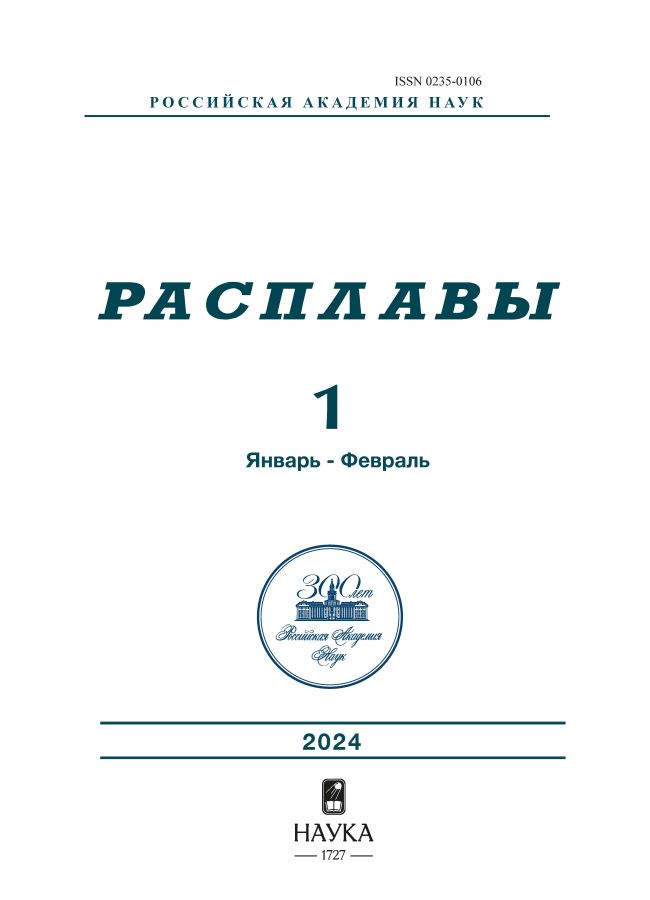Solubility of cerium in melts (NaCl–KCl)–CeCl₃ at a temperature of 850°С
- Autores: Shishkin V.1, Ivenko V.1
-
Afiliações:
- Institute of High-Temperature Electrochemistry, Ural Branch of the RAS
- Edição: Nº 1 (2024)
- Páginas: 60-66
- Seção: Articles
- URL: https://journals.rcsi.science/0235-0106/article/view/256463
- DOI: https://doi.org/10.31857/S0235010624010052
- ID: 256463
Citar
Resumo
Molten mixtures of chlorides of alkali and polyvalent metals have found wide application in the electrolytic refining of a number of metals, such as plutonium. The current efficiency in such processes depends on many factors, among which the most significant are the corrosion resistance of products made of ceramic materials in contact with melts, as well as the solubility of the metal to be purified in melts containing its chloride. Thus, when carrying out refining electrolysis to purify liquid cerium in a molten equimolar mixture of sodium and potassium chlorides with an initial concentration of cerium trichloride of 3 mol. %, it was possible to obtain a maximum current efficiency of 63%. It was shown that a significant part of the losses is due to the release of alkali metal and the dissolution of metallic cerium. There are no data on the solubility of a (polyvalent) metal in molten salt compositions containing its chloride in the literature. Therefore, the purpose of this work was to determine the solubility of metallic cerium in the (NaCl–KCl)–CeCl₃ melt at an electrolysis temperature of 850°C. An installation was created to determine the solubility of cerium with sampling of the salt melt without access to oxidizers. This was achieved by pouring the salt melt from the beaker, where the melt was saturated with cerium, into an external beaker without opening the device. It is shown that the solubility of cerium drops sharply with a decrease in the concentration of cerium trichloride and can be approximated by the equation: NCe = 1.67∙10–5∙x3–9.62∙10–4∙x2 + 4.50∙10–2∙x, NCe in mol. %, and x is the concentration of cerium trichloride in the melt in mol. %.
Palavras-chave
Texto integral
Sobre autores
V. Shishkin
Institute of High-Temperature Electrochemistry, Ural Branch of the RAS
Autor responsável pela correspondência
Email: V.Ivenko@ihte.uran.ru
Rússia, Yekaterinburg
V. Ivenko
Institute of High-Temperature Electrochemistry, Ural Branch of the RAS
Email: V.Ivenko@ihte.uran.ru
Rússia, Yekaterinburg
Bibliografia
- Shishkin V. Yu., Mityayev V.S. Ochistka galogenidov shchelochnykh metallov metodom zonnoy plavki [Purification of alkali metal halides by zone melting method] // Izv. AN SSSR. Neorgan. Materialy. 1982. 18. № 11. P. 1917–1918. [In Russian].
- Revzin G. Ye. Bezvodnyye khloridy redkozemel’nykh elementov i skandiya [Anhydrous chlorides of rare earth elements and scandium // In: Metody polucheniya khimicheskikh reaktivov i preparatov. 1967. № 16. P. 124–129. [In Russian].
- Korostelev P.P. Fotometricheskiy i kompleksometricheskiy analiz v metallurgii [Photometric and complexometric analysis in metallurgy]. M.: Metallurgiya, 1984. [In Russian].
- Yurist I.M., Talmud M.M. Selektivnoye kompleksonometricheskoye titrovaniye [Selective complexometric titration]. M.: Nauka, 1993. [In Russian].
- Babko A.K., Pyatnitskiy I.V. Kolichestvennyy analiz [Quantitative analysis]. M.: Vysshaya shkola. 1962. [In Russian].
- Melors G., Senderoff S. The phase diagram of the cerium — cerium trichloride system. // J. Phys. Chem. 1959. 63. P. 1110–1112.
- Novikov G.I., Polyachenok O.G. Galogenidy redkozemel’nykh elementov nizshey stepeni okisleniya [Halides of rare earth elements of the lowest oxidation state] // Uspekhi khimii. 1964. XXXIII. № 6. P. 732–747. [In Russian].
- Bredig M.A. Mixtures of metals with molten salts // Molten salts chemistry. 1964. P. 367–425.
- Smirnov M.V., Chebotin V.N., Kudyakov V. Ya., Loginov N.A. Elektronnyye perekhody mezhdu chastitsami v nestekhiometricheskikh ionnykh rasplavakh [Electronic transitions between particles in non-stoichiometric ionic melts] // Elektrokhimiya. 1977. XIII. № 5. P. 754–758. [In Russian].
- Smirnov M.V., Sokolovskiy Yu.S., Krasnov Yu.N. Ravnovesiye mezhdu tseriyem i yego dvukh- i trekhvalentnymi ionami v rasplavlennoy evtekticheskoy smesi khloridov litiya i kaliya [Equilibrium between cerium and its di- and trivalent ions in a molten eutectic mixture of lithium and potassium chlorides] // Tr. In-ta elektrokhimii UF AN SSSR. 1964. № 5. P. 7–16. [In Russian].
- Smirnov M.V., Ilyushchenko N.G., Komarov V. Ye. et al. Sposobnost’ rasplavlennykh shchelochnykh galogenidov vstupat’ v khimicheskiye reaktsii, prisushchiye metallam, nakhodyashchimsya v kontakte s nimi [The ability of molten alkali halides to enter into chemical reactions inherent in metals in contact with them] // In: Rasplavlennyye i tverdyye elektrolity. Sverdlovsk: UNTS AN SSSR. 1979. P. 34–38. [In Russian].
- Vasin B.D., Ivanov V.A., Naritsyn A.V. et al. Korroziya redkozemel’nykh metallov tseriyevoy gruppy v rasplavakh ekvimol’noy smesi khloridov natriya i kaliya [Corrosion of rare earth metals of the cerium group in melts of an equimolar mixture of sodium and potassium chlorides] // Rasplavy. 1998. № 6. P. 76–80. [In Russian].
- Tkatcheva O., Red’kin A., Shishkin V., Khokhlov V. Electrical conductivity of molten system KCl–CeCl3–Ce // High Temp. Material Processes. 1998. 2. № 4. p. 581–586.
- Ilyushchenko N.G., Anfinogenov A.I., Shurov N.I. Vzaimodeystviye metallov v ionnykh rasplavakh [Interaction of metals in ionic melts]. M.: Nauka, 1991. [In Russian].
- Kovalevskiy A.V., Soroka V.V. Reaktsionnaya yemkost’ galogenidnykh rasplavov, vyderzhannykh v kontakte s metallami [Reaction capacity of halide melts kept in contact with metals] // Rasplavy. 1988. 2. № 6. P. 28–32. [In Russian].
Arquivos suplementares










